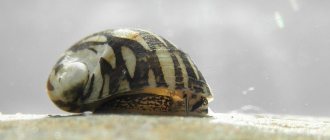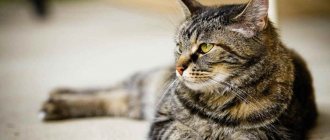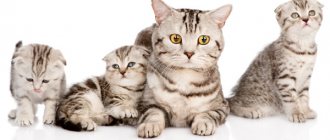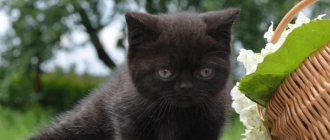Every loving owner is concerned about the proper and healthy nutrition of their pet. As you know, cats often eat meat - rodents, birds. The diet also includes carbohydrates (mice stomachs with semi-digested grains), calcium (dairy products) and other trace elements and minerals necessary for full growth and development.
An adult cat needs food filled with protein (about 150 grams per day), as well as carbohydrates (50 grams per day), water, vitamin supplements and ballast foods that aid digestion.
Preparing a place for a kitten
The cat's bed should be set up away from drafts, slamming doors, consumer electronics (including computer units) and sources of any loud sounds. These requirements are especially relevant when you offer your pet a rug instead of an autonomous house . Of course, a small Burmese will sleep on any soft fabric (towel, blanket), but as it grows, it is better to purchase or sew an oval/round bed with high sides.
Burmese cats (like many others) like to often change position and stretch out in their sleep, which is why they need a spacious bed, limited by sides for comfort. If the Burmese doesn’t like the house/bed, she won’t sleep there, but will choose a more comfortable place, for example, on the owner’s sofa.
You don’t have to worry too much about the toilet for a Burmese cat: any tray will do for her (with or without filler), the main thing is that the animal is not constrained in its movements when fulfilling its natural needs.
Another indispensable attribute of a cat’s life, as well as your peace of mind, is a scratching post, which you can also build with your own hands. The Burmese are taught to use this weapon from childhood, so as not to one day encounter torn wallpaper and scratched furniture.
Return to content
Reviews
In order to have a complete picture of the breed, I propose to consider some reviews from owners about their pets. All reviews are taken from the Otzovik website.
Affectionate and non-conflict animal
The review directly states: the cat’s behavior destroys all stereotypes about cats. The pet is patient with the child, friendly with guests and sociable with strangers, and has an affectionate and kind disposition. The author claims that the character of the Burmese is very similar to a dog.
Companion cat
The author of the second review says that they purchased the cat from a breeder, and not from a nursery, but the family did not regret their decision. Their pet really loves woolen products and chews them with pleasure. He is unpretentious when it comes to food, is not intrusive, and does not beg. He is smart and loves to have fun with active games. The animal is sincerely attached to its owners and is sad in their absence. At the same time, the cat quickly settled in with the author’s relatives when he stayed with them for foster care.
Cat with character
The author of the following review says that she was unlucky with the breeder: the kitten was not accustomed to the tray and scratching post and caused a lot of inconvenience. After some time, the review was updated: the cat became accustomed to the rules of the house, but retained its willfulness and some aggressiveness. He remembers what the owner doesn’t like and doesn’t ruin things. She has a dog-like personality - she happily jumps around her owner and responds to her name.
Caring for a Burmese cat
The weakest points of the Burmese (individual breed lines) are considered to be the eyes, nose and teeth. Otherwise, all care procedures are not much different from standard manipulations with other cats.
Cleaning ears, eyes, nose
Due to the structure of their faces, modern Burmese cats often suffer from increased lacrimation, so their eyes are regularly cleaned of discharge using a cotton pad or swab with a mild antiseptic.
For sore eyes, use drops:
- tsiprovet;
- iris;
- maxitrol.
If symptoms persist, contact a clinic.
Important! Short-nosed American Burmese, more than European ones, are prone to runny noses, so owners of the former should pay increased attention to the free breathing of their pets and the cleanliness of their nasal passages.
The ears are examined once a week, removing excess wax with a moistened cotton pad. Ear care will be made easier by drops that your doctor will recommend. If a cat constantly scratches and even tears its ear, it means that ear mites have settled there, which must be removed with special drops.
Grooming
The Burmese cat has a close-fitting, short and very smooth coat that is easy to care for. Brush your Burmese once a week with a silicone/rubber mitten or a regular brush - this will be enough.
If you want to add shine to the coat, go over it (after brushing) with suede or silk. Before a show, as well as during shedding periods, cats are brushed a little more often.
Professional hair care will be provided by a device such as a furminator . It is not very cheap, but it effectively removes dead hair, making the fur of the Burmese cat even more well-groomed and shiny.
Care for claws and teeth
Look into your pet's mouth often, as Burmese cats have been shown to have a hereditary predisposition to gum inflammation (gingivitis). The examination should be accompanied by teeth cleaning, preferably once every 7 days.
Important! If you find tartar, take the Burmese to the hospital: the dentist will remove the stones and at the same time treat teeth affected by caries. Self-removal of tartar is not recommended, since at home it is easy to infect the mucous membranes.
Some owners regularly, but not more than once a month, trim their Burmese's claws. To do this, they use nail clippers, cutting off 1-2 mm from the claw, trying to get around the pulp. The procedure requires skill and self-control, so if you are unsure of your own abilities, it is easier to turn to a groomer.
Bathing and washing
If your Burmese does not clean chimneys and sits at home, it is better to leave it alone and not subject it to water procedures without a reason, which could be participation in an exhibition or noticeable pollution. The coat of the Burmese cat is impervious to dirt; moreover, the breed is characterized by increased disgust and a desire for cleanliness.
If you really want to bathe your Burmese, do it about once a quarter using shampoo for short-haired cats. When bathing, protect her ears by covering them with cotton wool and showering only her body: gently wash her head with your hand. To avoid drying out the Burmese's skin, after bathing, pat its coat dry with a soft towel and skip the hairdryer, giving you the opportunity to clean yourself up away from the draft.
Return to content
Historical reference
Temple inhabitants, Burmese cats, were considered deities in ancient East Asia. Such unusual animals were worshiped, and caring for the Burmese was considered a high honor by the monks and was considered one of the steps leading closer to God. Any insult inflicted on the Burmese could cause terrible punishments during life and torment after death. According to many ancient beliefs, cats of this breed were obliged to accompany their owners even after their transition to another world.
The presence of a short-haired Burmese cat in the house promised the owner great happiness, financial wealth and absolute harmony in life. The most noble people sought to have such a pet, so for a long time Burmese kittens were considered a truly luxurious and very expensive gift, not affordable for mere mortals.
In palaces, cats of this breed appeared even earlier than the famous Siamese cats, and also enjoyed truly genuine favor among the entire royal family. Information about the breed can be found in most ancient manuscripts or books published in Thailand and Burma. Many chroniclers immortalized the animal on the pages of books, in stories about mysterious and wonderful animals. And this is partly why the origin, history, amazing qualities and legends dedicated to such an unusual pet have now become known to the whole world.
Diet features
It is worth considering that the Burmese cat always has a good appetite, which is why fat deposits on the sides are deposited very quickly . This is not welcomed by the standard, since the Burmese, although called “a brick wrapped in silk,” is obliged to look elegant and harmonious.
That is why the diet of Burmese cats should contain only high-quality food (holistic and super-premium) with a high concentration of animal protein and vitamins. The active components of such foods help maintain excellent muscle tone and shiny coat, which is considered the hallmark of the breed.
This is interesting! Tomatoes and strawberries (if the cat does not suffer from allergies), as well as solid food that prevents deposits on teeth, will help prevent gingivitis and the formation of tartar.
The Burmese natural menu includes:
- meat (raw and cooked);
- sea fish (fresh and boiled);
- fermented milk products (without fruit fillers);
- chicken eggs;
- vegetables (in any form);
- liver (fresh/boiled);
- porridge.
A natural diet requires vitamin and mineral supplements, which are mixed with ready-made meals. Adult Burmese are fed twice a day, adolescents - three times, pregnant cats and small kittens - four times a day.
Don't forget about the right dishes: it is better to use stable bowls made of ceramic or thick glass. Some metal cups give water/food a bad taste, and plastic not only smells bad, but also contains toxic substances.
Return to content
Castration and sterilization
If a cat or cat is not intended for breeding, then they should be spayed or sterilized.
At what age is it recommended to sterilize an animal?
In the past, it was recommended that spay and neuter surgeries should not be performed until the female cat reached eight months of age. However, early castration is now increasingly being performed - at approximately 4 months of age. Experienced breeders, selling kittens as pets at 16 weeks of age, give the new owner an already sterilized cat or neutered cat. Sterilization is effective both at 4 and 8 months.
Caring for your pet after surgery
After the operation, the cat is put on a special blanket that will protect the seam from licking. The cat owner makes sure that the pet does not have hypothermia, and that there is clean water nearby. If your pet does not drink, then she must be given water forcibly, through a syringe without a needle. You can feed on the second day after surgery, offering the animal a portion three times smaller than usual. On the third day, you can switch to your normal diet.
The blanket is not removed from the cat until 2–3 days have passed after the sutures have been removed, which usually occurs 7–10 days after surgery. Until the seam heals, the owner will have to carefully monitor the cat’s condition, treat the seam with an aseptic solution once a day, and provide warmth for the pet. When the sutures heal (and this depends on the individual characteristics of the cat and its absence of concomitant diseases).
A cat after castration requires much less attention from its owners. The incision is minimal (about 1 cm), and there are no stitches. The owner needs to provide the cat with warmth, drink and rest. Usually the cat is given a special collar to prevent licking. Drinking and feeding are carried out according to the same scheme as for a cat after sterilization. Healing usually proceeds quite quickly, and after 2-3 days the cat returns to its normal lifestyle.
Diseases, breed defects
Due to their different anatomical structures, American and European Burmese are somewhat different in the set of typical genetic ailments . Thus, modern-type Burmese are free from the dangerous hereditary disease GM2-Gangliosidosis, which is found among classic Burmese cats. The disease begins with loss of coordination, develops rapidly, flowing into paralysis, and ends with the death of the animal. The difficulty is that the disease, although congenital, manifests itself at 3 months of age, when the kitten finds a new owner.
Burmese are often diagnosed with hypokalemia (lack of potassium), which is evidenced by such initial symptoms as lethargy and increased fatigue. To prevent the disease from ending in paralysis, the cat is given potassium or added to the food. Burmese kittens are sometimes born with FCKS (flat chest syndrome), where not only the sternum is deformed, but also the ribs.
This is interesting! Burmese with FCKS overcome two crises, on the 10th and 21st days. A baby who survives for more than 3 weeks usually lives a normal cat life, regardless of the correction of the sternum.
Due to the shortened nose (and short nasal passages) of the American Burmese, the owner is obliged to protect it from hypothermia and colds that cause a runny nose. In addition, the following are recognized as genetic diseases of the Burmese cat:
- endocardial fibroelastosis;
- eye diseases, including erosion of the third eyelid cartilage;
- lethal defects of the midfacial zone;
- dry eye syndrome;
- herniation of the meninges/brain;
- diabetes;
- skull deformation;
- orofacial pain syndrome.
Certain lines of European Burmese have difficulty giving birth and have a high risk of caesarean section. In contrast, modern Burmese cats give birth easily and require almost no surgical intervention during childbirth.
Return to content
NUTRITIONAL SUPPLEMENTS
Sodium chloride (table salt)
Excess salt causes hypertension, heart disease and kidney disease. You should not add salt to the food you prepare for cats.
Bone flour
It is useful to give it to cats that refuse milk and milk products. Flour can be mixed with meat or added to other dishes. Kittens, pregnant and lactating cats, as well as animals with broken bones should be given one teaspoon of bone meal every day. In case of mild intestinal disorder, it has a strengthening effect.
Raising a Burmese cat
Cat trainers have long paid attention to the Burmese with their attractive appearance, artistry, increased IQ, desire to always be in the center of attention and please a person. Circus performers know that training a Burmese is an entire art, since the cat remembers its natural behavior patterns, which must either be supported or weakened . After the peculiar behavior of the Burmese is accentuated and consolidated, you just need to come up with a scene where the cat will look most organic and impressive.
In turn, biologists have found that motivation for cats is much more important than for dogs: the Burmese must want to express itself in a certain way. If a dog needs a treat to reinforce a skill, it does not work in the case of a cat: the latter comes from its love for its owner and the desire to play.
British researchers have also found that a cat's sociability, as well as the degree of its trustfulness towards humans, is genetic and inherited on the paternal side. And since the cat’s father never participates in the upbringing of his children, the British conclusion has so far become the only evidence of the influence of the male on the offspring.
Important! The most favorable period for raising and training a Burmese cat is considered to be the interval from its birth to six months of age.
Remember that when raising a Burmese, you must use the method of positive reinforcement, and you must choose tricks and the corresponding commands solely taking into account her inclinations and preferences.
The Burmese cat, like other animals, is not ready to perceive complex speech patterns and changing verbal forms. The command should be concise and consist of one word (“sit!”, “eat!”, “bring!”), to which new words should not be added. Commands are pronounced once, clearly and without changes.
Remember that Burmese cats are very playful, but you still should not entertain cats with your bare hands, or allow them (even in a playful way) to throw themselves on your feet. The Burmese is filled with a desire to please its owner, which is why it becomes a grateful and well-trained pupil. You just need to be patient and loving to achieve exemplary obedience and understanding from your cat.
Return to content
Table: pros and cons of the breed
| Pros of the Burmese cat breed | Disadvantages of the Burmese cat breed |
| 1. High contact and communication skills | 1. Doesn't tolerate loneliness well |
| 2. Attachment to a person | 2. Increased curiosity |
| 3. Lack of aggression | 3. Early puberty |
| 4. Tolerance towards children | 4. Frequent and loud heats |
| 5. Get along with other animals | 5. High cost |
| 6. No content complications | |
| 7. Good health | |
| 8. Good learning ability | |
| 9. Activity and playfulness |
Dry or canned food: what to choose?
The main advantage of dry food is its long shelf life and the ability to be placed in an automatic feeder. This type of food allows you to either leave your pet alone at home for a while or take it with you on a trip. However, other characteristics of this product must be taken into account. According to scientific research, Burmese cats that eat dry food are more likely to have problems with the urinary system. By soaking the crackers with water, the risk of disease is reduced. Owners need to strictly monitor the presence of liquid in the cat’s bowl and control the amount of water they drink. If by nature your pet drinks little liquid, it is better not to give him dry food. Also, do not forget that soaked granules cannot be stored for a long time - they deteriorate and lose their beneficial properties.
It is not recommended to frequently change types of food, as your pet may become stressed and get sick. Using dry food only when traveling leads to disorders of the body's functional processes. It is best to accustom your pet to dry granules gradually, increasing the dose of food each time. Buying a previously untried product on the road is not a good idea. Owners of furry friends are concerned about the question of whether it is possible to combine dry food with canned or natural food. Manufacturers do not recommend giving animals different foods: natural food and canned food should be separated. However, not all owners follow this rule and can feed the cat from time to time not only canned food, but also meat, boiled yolks and dairy products.
Unfortunately, combining feeds causes problems. In this situation, it is difficult to adhere to complete and balanced meals and monitor the consumption of the required amount of water. With mixed feeding, cats often drink very little liquid. Moreover, your pet experiences different types of digestion due to the mixing of food.
Remember: changing food leads to a deterioration in the overall health of the pet. You can choose high-quality and proven canned goods, but their cost will be high. If possible, use group purchasing with other breeders.
Obesity in a Burmese cat
Pets, being in a home environment, can quickly gain extra pounds. Cats are lazy and do not actively move or hunt. In addition, improper eating habits provoke obesity. There is no need to give your furry friend spicy and fatty foods from the table, also exclude too large portions of food and stick to a balanced diet.
Spayed or neutered animals are more likely to have problems with excess weight. In such cases, it is necessary to feed your pets according to their diet, choosing high-quality and suitable food.
FATS
Vegetable fats
The main source of polyunsaturated fatty acids and vitamin E is any vegetable oil that should be added to cats’ food.
Animal fats
Cats need a small amount of fat and traditionally receive it in the form of butter, margarine and sour cream, pieces of fatty meat that pass to them from our table. Animal and milk fats contain vitamins A, D, E, phosphates, and choline. With a lack of fat, the following are observed: growth retardation, dermatitis, depigmentation of hair. Lethargy, raised dull hair, excess weight are signs of an overdose of fat.
CARBOHYDRATES
Carbohydrates are contained in the following products: cereals, oat and corn flakes, flour products. In carnivores, which include the cat, they are not actually absorbed, but they contribute to the effective absorption of the main food.
Cereals
You can give oatmeal, buckwheat, semolina. Porridge should be cooked in water. The experience of breeders of long-haired breeds who adhere to regular feeding suggests that cat hair is good only in this case, when porridge is included in the diet.
Flour products
Suitable for feeding cats, but in moderation. Vermicelli with cheese and added vegetable oil is readily eaten by cats. Some cats love rye bread, which is useful as a source of B vitamins.
Chocolate and sweets
Chocolate contains theobromine, which is toxic to cats, and is also high in fat, so should not be given to cats. In principle, cats do not have receptors sensitive to sweets, but some cats have a “sweet tooth.” You can let your cat eat a cookie or a lump of sugar, without forgetting that their consumption leads to obesity and tooth decay.
Socialization
Burmese kittens, like adults, do not tolerate loneliness well. But this is easy to deal with - just spend more time with your baby. Contact with a person promotes rapid adaptation to a new family, and the baby will grow up affectionate and playful. In the future, the Burmese easily makes contact with people, easily gets along with other animals, and does not pose a danger to children. By the way, owners of Burmese kittens should know that animals experience discomfort when they witness quarrels.











